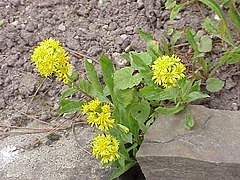Solidago virgaurea
| Solidago virgaurea subsp. var. | Goldenrod, Aaron’s Rod | |||||||||||||||||||||||||||||||||||||||||||||||||||||||
|---|---|---|---|---|---|---|---|---|---|---|---|---|---|---|---|---|---|---|---|---|---|---|---|---|---|---|---|---|---|---|---|---|---|---|---|---|---|---|---|---|---|---|---|---|---|---|---|---|---|---|---|---|---|---|---|---|

|
|
| ||||||||||||||||||||||||||||||||||||||||||||||||||||||
| ||||||||||||||||||||||||||||||||||||||||||||||||||||||||
Solidago virgaurea (goldenrod or woundwort) is an herbaceous perennial plant of the family Asteraceae. It is grown as a garden flower with many different cultivars. It flowers profusely in late summer.
| Standard Cyclopedia of Horticulture |
|---|
|
Solidago virgaurea, Linn. European Goldenrod. A rough simple-stemmed but stout perennial 1-3 ft. high: basal lvs. 4-7 in. long, 2 – 2 1/2 in. wide, obtuse or acute; upper lvs. sessile or narrowed into margined petioles: fls. in a dense terminal, rather narrow and often interrupted thyrsus which is often 8-10 in. long: bracts of the involucre acute or acutish. Eu.—One of the best garden plants of the group. A prostrate form is offered. S. cambrica, Huds., is a compact and dwarf form, 6 in. or less high, with larger heads. S. Virgaurea is represented in the U. S. by S. Cutleri, Fern. (S. Virgaurea var. alpina, Bigel.), in the highest alpine districts of N. New England and N. Y.; this American species appears not to be in the trade. CH
|
Cultivation
Propagation
Pests and diseases
Varieties
Gallery
References
External links
- w:Solidago virgaurea. Some of the material on this page may be from Wikipedia, under the Creative Commons license.
- Solidago virgaurea QR Code (Size 50, 100, 200, 500)
